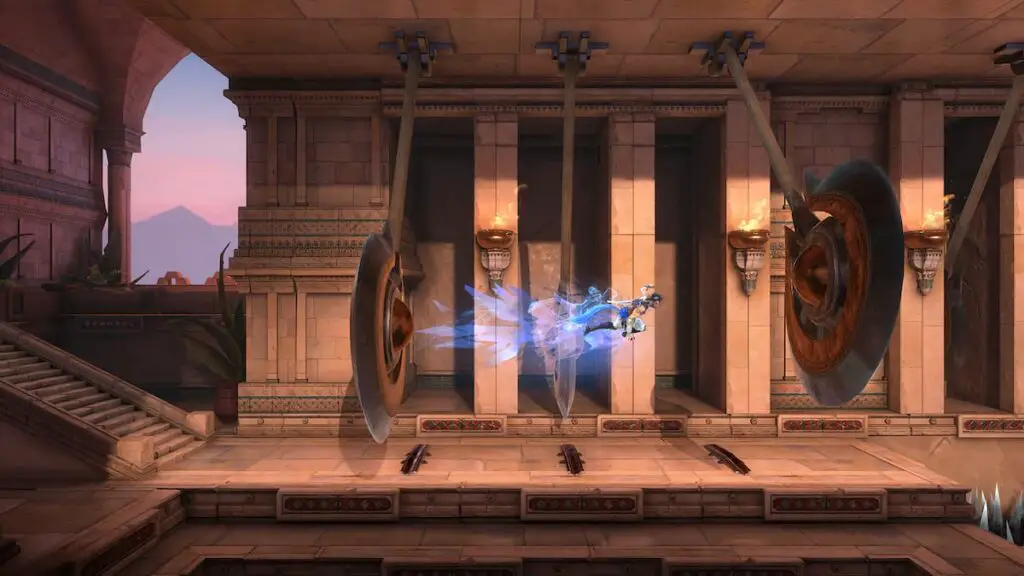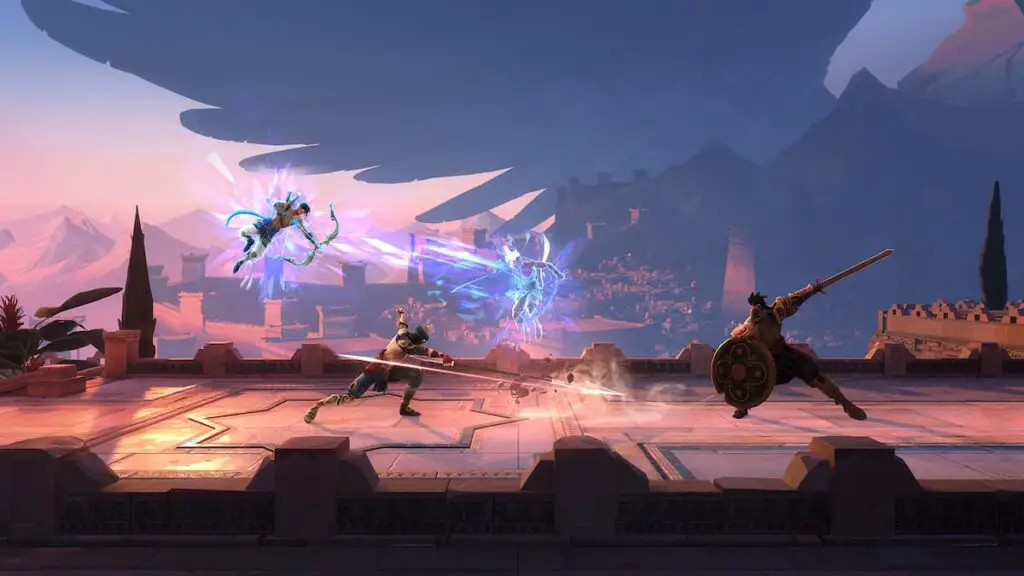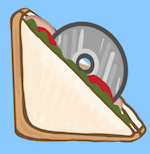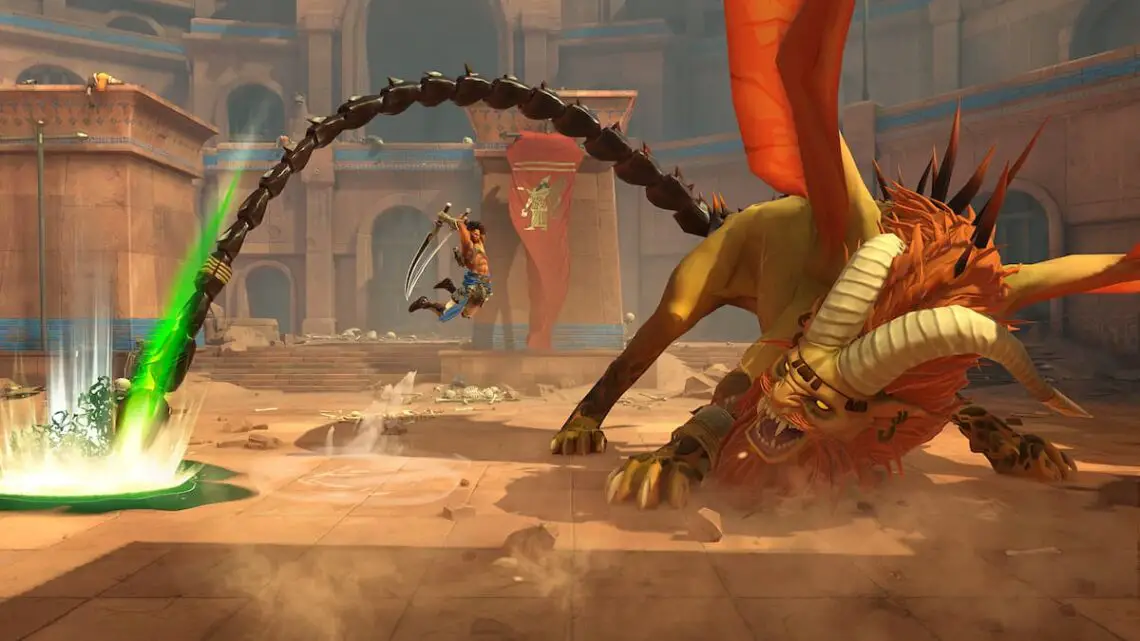Metroidvanias have always been hit-and-miss with me. I’ve never gotten into the Metroid and Castlevania games that so many people love, but there are a select few that truly captured me. The Ori and Shantae games, in particular, stand out. I love the stories and colorful personalities behind those games, but I feel those games exceed most in providing a gameplay experience that catches me and holds my attention. With that in mind, my excitement going into Prince of Persia: The Lost Crown was middling at best. This is a series that I also have hardly touched, with my only experience being the 2008 reboot on Xbox 360. That is why I am exceedingly happy to say this is one of the best Metroidvania games ever made.
Running through these sands never gets old

What truly makes The Lost Crown stand out is its highly addictive platforming and combat. Like other games of this type, you start with a basic moveset. The combat feels a little button-mashing heavy as you get used to the controls. You have one button for your melee attacks and will need to mix in a steady dose of dodging and parrying to survive. Time a parry at the right moment against certain enemies, and you trigger a cinematic finishing move that always felt highly rewarding to pull off as a reward for your good timing. As the game progresses, things truly expand. New abilities that let you manipulate time to teleport, double jump, and fling yourself across the air expand your options in both combat and exploration. You can also change up your melee attacks by using the directional stick. This allows you to add complexity to your moves, such as juggling enemies by sending them in the air. It’s a level of fast, frantic fighting that feels like what I imagine Devil May Cry would were it 2D.
Platforming also expands with these new abilities, and this was unquestionably my favorite part of the game. Running around the map in The Lost Crown has you taking on so many different challenges that gradually increase in difficulty but never feel like they are completely out of reach. Considering all of the different moves and how challenges expand and test you, I found this to be the best 2D platforming I have experienced since Celeste, which I consider to be the gold standard for the genre. Instead of a linear journey constantly throwing those challenges at you to block your progress until you overcome them, you can more or less choose what you want to take on now or maybe come back to later.
Time (and the difficulty settings) will be at your aid

For the most part, the combat and platforming always feel top-of-the-line, with very few blemishes. Prince of Persia: The Lost Crown is a very challenging game. I started the game playing at the standard difficulty, which I stuck to for about half my playtime. However, the boss battles in this game can hit a level where even that “normal” difficulty felt too much for me. As you play, you will find various amulets that change your stats or abilities in certain ways, and there are plenty of upgrades available for those who want to seek them out, but even these progressions didn’t feel enough to put me over the hump.
Every boss battle has a set of moves that test you to use the proper ability at the right time, but they move so quickly and hit so hard that I hit a brick wall in my progression. Of course, you could always leave the boss fight and do more exploring to find more resources to upgrade or equip new amulets to mitigate the challenge, but that wasn’t something I wanted to do. Luckily, you can alter the difficulty in the settings at any time, and this was a lifesaver for me. Moving things down to the story mode difficulty put me back on track. However, I then later hit a boss that even story mode difficulty was too tough, forcing me to lower it even further so I could beat a boss that wasn’t even connected to the final boss. With all of that said, I almost never felt like things were unfair. There might have been a move or two that I didn’t know how to approach, and in one case, I hit a bug where the entire environment disappeared and masked the boss’ attacks. Aside from that, I always felt like my death was due to my own mistakes and I just needed to rise above that challenge. The game is very tough but also fair.
What is at the end of your blade?

The opening portion of Prince of Persia: The Lost Crown can feel a little long in the tooth as you wait for the story to really take off. Once it opens up and gives you the opportunity to explore freely around an hour in, the game instantly becomes something you don’t want to put down. All around the map are Wak-Wak Trees, and these act similarly to bonfires in Dark Souls. Every time you interact with one, your health and resources are restored, your game saves, enemies respawn, and if you want, you can change your amulets and special combat abilities here. Sometimes there’s also a weird head creature inside the tree you can talk to, but they don’t do anything from what I saw. One acted as a light in a dark place for one spot of the journey, but I found their inclusion to be entirely unneeded. One of the weirder choices I found for the game is the inability to fast travel between these locations. Instead, you have to find very particular statues that you fix and then can move between. These statues are always placed near a Wak-Wak Tree, but not every tree has them. To save a little on running back and forth, I would have rather just been able to fast travel between the trees.
In this story, you actually don’t play as the titular prince that many people are familiar with. Instead, you are Sargon, a member of the Immortal group: warriors who defend Persia from whatever threats present themselves. During this story, Persia is at war, and you begin the game by driving back an army and taking down a general. When the Immortals return to the palace to celebrate, the current standing prince of Persia is abducted by your mentor and taken to a palace trapped in a weird time rift, truly kicking off your quest to rescue him and opening the game. Overall, the story is good but not great. It serves more as a device to get you to move to various points of the map to either find a new ability or get a new item than tell a deep or compelling narrative.
That brings me to an aspect that has always been a deterrent in Metroidvanias: backtracking. I have never enjoyed the act of revisiting areas to access paths that were out of reach on my first arrival. Yes, there is plenty of that happening here, which I still find annoying, but I think I am more accepting of it here for how different every environment in the game is. Every section of the map has a different theme, and in it are unique enemies and hazards. One moment, you are moving through a Persian city filled with undead enemies, and the next you’re walking along a pirate ship frozen in time as it is crashing in a storm. The story pushes you through each of these locations and never makes a big deal about the changes, but I truly enjoyed how subtly the transitions take place. The map is large, but it’s vibrant and hides all kinds of secrets to encourage and reward exploring the detailed environments. It is a stark contrast to typical Ubisoft games that bloat a single biome and fill it with copy-pasted enemies.
I played The Lost Crown on Nintendo Switch, and for the most part, the game holds up visually. There were quite a few performance drops as frames started stuttering a little in random spots, but it was never to a degree that I felt things were unplayable. Loading took a few seconds in some areas, most notably when I went to fast travel, but it never felt super long. I expect the PS5 and Series X to breeze through loading screens in this game. Someone who pays more attention to these kinds of performance markers with a magnifying glass may find more warts than I did, but I was very happy with how the game performed on Switch. Not once did it ever take away from the great time I was having.
Final verdict
Prince of Persia: The Lost Crown is a triumphant return for the series. While originally the Sands of Time remake was envisioned as the series’ revival, this new direction is a far better fit. The combat and traversal are fast and fluid while challenging your abilities to the core, and you always feel like you are getting stronger with new abilities and upgrades. The puzzles can be daunting at first, but they’re not too tough to figure out after a little critical thinking, and the variety in environments kept me wanting to see what the next deathtrap I encountered could be.
Ubisoft has mostly felt like it didn’t know what to do with the Prince of Persia franchise the last decade or so, but The Lost Crown proves that the Prince can thrive when given games of this style and substance. As someone who doesn’t typically connect with this kind of game, I was surprised to be won over so handedly here. It has earned a place among the best the Metroidvania genre has to offer and is a brilliant way to open up 2024.
Prince of Persia: The Lost Crown was reviewed on Nintendo Switch with a code provided by Ubisoft. It is also available on PC, PlayStation, and Xbox on January 18, 2024.
More from us:
Avatar: Frontiers of Pandora – Heavy-Handed Beauty
The Review
PROS
- A masterclass in 2D platforming
- Challenging combat that makes good use of every tool at your disposal
- Expertly tuned puzzles and problem solving
- Diverse and highly detailed environments
CONS
- Backtracking feels like a chore
- A few performance hiccups on the Nintendo Switch
- Demanding boss fights that feel like a wall






